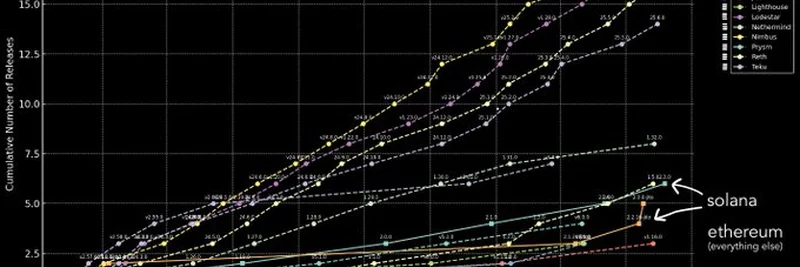Hey there, meme coin enthusiasts and blockchain buffs! If you’ve been scrolling through X lately, you might have stumbled upon a juicy debate about Ethereum and Solana’s client release timelines. The post by nixo.eth has set the crypto world abuzz with a fresh take on this rivalry, complete with a revamped graph that’s turning heads. Let’s break it down and see what’s cooking in this blockchain showdown!
The Spark That Started It All
It all began with a graph from Brian showcasing Solana’s Agave client updates, boasting an impressive six releases in just 15 months. The crypto community was quick to praise Anza, the team behind Solana’s updates, for making it look effortless. But not everyone was impressed. Some pointed out that comparing Solana’s frequent minor updates to Ethereum’s major, coordinated releases—across 10 client teams—might not be a fair fight.
Enter nixo.eth, who decided to spice things up with a counter-graph titled Client Release Timeline (Ethereum vs Solana). This updated visual focuses on major milestone releases rather than the sheer number of updates, leveling the playing field. The graph, embedded below, tells a story of its own:
What the Graph Reveals
At a glance, the graph plots the cumulative number of releases over time, with Ethereum’s multiple clients (like Lighthouse, Nethermind, and Prysm) and Solana’s Agave standing out. Here’s the juicy bit: while Solana’s line (highlighted with an arrow) shows steady growth, Ethereum’s collective effort—labeled “everything else”—demonstrates a denser cluster of releases, especially in recent months. Nixo’s point? Comparing raw release counts is “pretty silly data” when the complexity of coordination differs so wildly.
For those new to the scene, a “client” in blockchain terms is like a software version that nodes (the computers running the network) use to validate transactions. Ethereum, being a decentralized giant, juggles multiple clients to avoid a single point of failure, while Solana leans on Agave as its primary client, with plans for multi-client support like Firedancer on the horizon.
The Community Weighs In
The X thread exploded with reactions. Sassal.eth gave a nod to nixo’s effort, while others like jasperthefriendlyghost.eth dropped a hilarious Mario meme to crown nixo the “king” of this debate. Comments ranged from “aura maxxing” to questions about whether this is turning into a “client war.” It’s clear this isn’t just tech talk—it’s a full-on meme-fueled rivalry!
Why It Matters for Meme Token Fans
So, why should you care if you’re into meme tokens? The speed and reliability of client updates can impact network performance, which directly affects transaction costs and speed—key factors for meme coin traders. Solana’s low fees and high throughput make it a favorite for meme token launches, while Ethereum’s robust ecosystem supports a wider variety of DeFi and NFT projects, including meme coins. A smoother update process could mean faster adoption of new features, giving one network an edge over the other.
The Bigger Picture
This debate ties into broader blockchain trends. Ethereum’s ongoing upgrades, like the Pectra update, aim to boost scalability, while Solana’s Agave 2.0 (set to launch post-Breakpoint 2024) promises a multi-client future. Both networks are racing to stay ahead, and this X thread is a snapshot of that competition. Whether you’re rooting for Ethereum’s decentralized might or Solana’s sleek efficiency, the data suggests both are pushing the envelope—just in different ways.
What do you think? Is nixo’s graph the ultimate mic drop, or will Solana’s team fire back with more updates? Drop your thoughts in the comments, and stay tuned to meme-insider.com for more blockchain tea spiced with meme coin flair!

